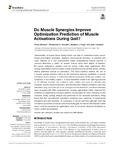Mostrar o rexistro simple do ítem
Do Muscle Synergies Improve Optimization Prediction of Muscle Activations During Gait?
| dc.contributor.author | Michaud, Florian | |
| dc.contributor.author | Shourijeh, Mohammad S. | |
| dc.contributor.author | Fregly, Benjamin J. | |
| dc.contributor.author | Cuadrado, Javier | |
| dc.date.accessioned | 2020-09-17T14:55:23Z | |
| dc.date.available | 2020-09-17T14:55:23Z | |
| dc.date.issued | 2020-07 | |
| dc.identifier.citation | Michaud F, Shourijeh MS, Fregly BJ and Cuadrado J (2020) Do Muscle Synergies Improve Optimization Prediction of Muscle Activations During Gait? Front. Comput. Neurosci. 14:54. doi: 10.3389/fncom.2020.00054 | |
| dc.identifier.issn | 1662-5188 | |
| dc.identifier.uri | http://hdl.handle.net/2183/26208 | |
| dc.description.abstract | [Abstract] Determination of muscle forces during motion can help to understand motor control, assess pathological movement, diagnose neuromuscular disorders, or estimate joint loads. Difficulty of in vivo measurement made computational analysis become a common alternative in which, as several muscles serve each degree of freedom, the muscle redundancy problem must be solved. Unlike static optimization (SO), synergy optimization (SynO) couples muscle activations across all time frames, thereby altering estimated muscle co-contraction. This study explores whether the use of a muscle synergy structure within an SO framework improves prediction of muscle activations during walking. A motion/force/electromyography (EMG) gait analysis was performed on five healthy subjects. A musculoskeletal model of the right leg actuated by 43 Hill-type muscles was scaled to each subject and used to calculate joint moments, muscle–tendon kinematics, and moment arms. Muscle activations were then estimated using SynO with two to six synergies and traditional SO, and these estimates were compared with EMG measurements. Synergy optimization neither improved SO prediction of experimental activation patterns nor provided SO exact matching of joint moments. Finally, synergy analysis was performed on SO estimated activations, being found that the reconstructed activations produced poor matching of experimental activations and joint moments. As conclusion, it can be said that, although SynO did not improve prediction of muscle activations during gait, its reduced dimensional control space could be beneficial for applications such as functional electrical stimulation or motion control and prediction. | es_ES |
| dc.description.sponsorship | This work was funded by the Spanish MICIU under project PGC2018-095145-B-I00, co-financed by the EU through the EFRD program, and by the Galician Government under grant ED431C2019/29. Moreover, FM would like to acknowledge the support of the Spanish MINECO by means of the doctoral research contract BES-2016-076901, co-financed by the EU through the ESF program | es_ES |
| dc.description.sponsorship | Xunta de Galicia; ED431C2019/29 | |
| dc.language.iso | eng | es_ES |
| dc.publisher | Frontiers Media S. A. | es_ES |
| dc.relation | info:eu-repo/grantAgreement/AEI/Plan Estatal de Investigación Científica y Técnica y de Innovación 2017-2020/PGC2018-095145-B-I00/ES/ESTUDIO DE LA RELACION ENTRE EFICIENCIA Y NIVEL DE DETALLE EN MODELOS BIOMECANICOS DEL CUERPO HUMANO/ | |
| dc.relation | info:eu-repo/grantAgreement/AEI/Plan Estatal de Investigación Científica y Técnica y de Innovación 2013-2016/BES-2016–076901/ES/ | |
| dc.relation.uri | https://doi.org/10.3389/fncom.2020.00054 | es_ES |
| dc.rights | Atribución 4.0 Internacional | |
| dc.rights.uri | http://creativecommons.org/licenses/by/4.0/ | |
| dc.subject | Static optimization | es_ES |
| dc.subject | Synergies | es_ES |
| dc.subject | Gait | es_ES |
| dc.subject | Muscle forces | es_ES |
| dc.subject | EMG Validation | |
| dc.title | Do Muscle Synergies Improve Optimization Prediction of Muscle Activations During Gait? | es_ES |
| dc.type | info:eu-repo/semantics/article | es_ES |
| dc.rights.access | info:eu-repo/semantics/openAccess | es_ES |
| UDC.journalTitle | Frontiers in computational neuroscience | es_ES |
| UDC.volume | 14 | es_ES |
| UDC.issue | 54 | es_ES |
| dc.identifier.doi | 10.3389/fncom.2020.00054 |
Ficheiros no ítem
Este ítem aparece na(s) seguinte(s) colección(s)
-
LIM - Artigos [43]






